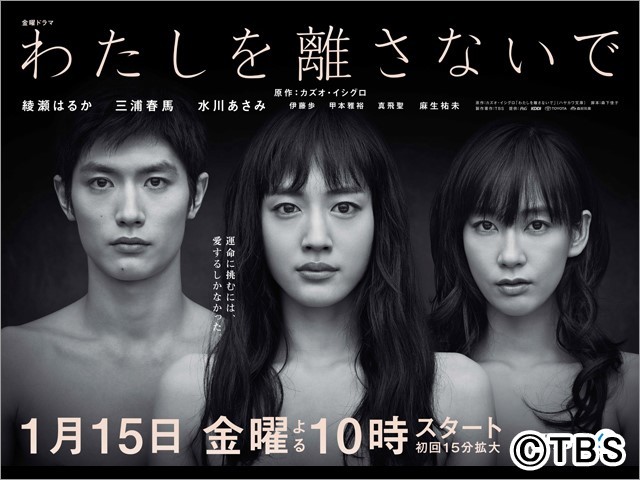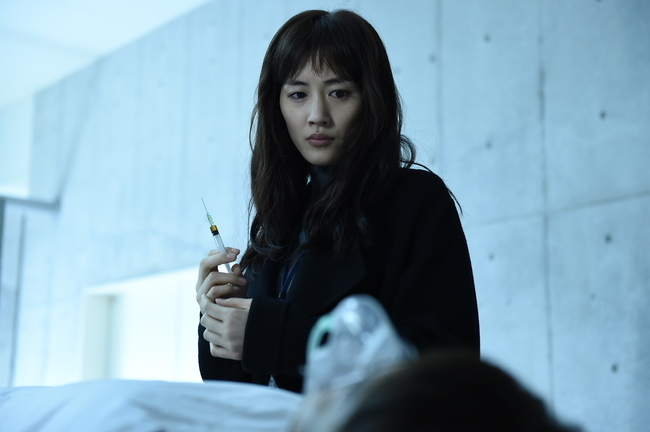Abstract
TBS’s 2016 adaptation of Kazuo Ishiguro’s novel Never Let Me Go elicits a particular irony of language in that the Japanese word teikyō means both ‘sponsorship’ and ‘donation’. In Ishiguro’s unsettling dystopia, clones donate their organs to ailing humans, becoming the ultimate consumer items. But lead actress Ayase Haruka’s appearances as various ‘clones’ of herself in the numerous advertisements punctuating the Japanese drama constitute a breach of the ‘fourth wall’ that not only undermines the anti-consumerist message of its literary progenitor but also exemplifies the burgeoning commercial intrusion into the fictive space of Japanese audiovisual media.
Keywords: Kazuo Ishiguro, dystopian fiction, Japanese drama, consumerism
Newly minted Nobel laureate Kazuo Ishiguro was born and lived in Japan until the age of five, when his family moved to the UK. He writes exclusively in English, and while he has used Japanese settings in early novels A Pale View of Hills (1982) and An Artist of the Floating World (1986), he considers himself an international novelist, someone who worries about being too parochial for a global audience.
That said, Japan has a special relationship with this global author, as a kind of literary prodigal son. He is regarded with awe, and not a little local pride – particularly in the wake of his Nobel Prize for literature – but his name is now written in the Western order, with the family name last, and in katakana, the script usually reserved for the transliteration of foreign words.
Never Let Me Go the novel (2005) was translated into Japanese by Tsuchiya Masao in 2006, and Mark Romanek directed the Western film adaptation in 2010. Apart from the occasional attempt at a theatrical staging, that was where the story remained until 2016, when the Japanese television station Tokyo Broadcasting System (TBS) decided to ‘reclaim’ – or perhaps ‘re-orient’ –Never Let Me Go, making it part of the worldwide trend towards long-form televisual treatments of novels in preference to one-off films, if not indeed one of the localisation of global properties.
|
Promotional image for Watashi o hanasanaide, showing the love triangle of characters Tomo, Kyōko and Miwa, played by three of Japan’s most famous young actors. © TBS. |
Never Let Me Go appears at first glance an ideal property for Japanese television. Its globally successful author has a Japanese name and Japanese roots, an established Japanese translation exists, and a Western film version has already blazed the path to adaptation [audiovisual]. The novel has a vaguely science-fiction premise, the ‘hot topic’ of cloning, for which, as filmmakers as far back as Andrei Tarkovsky have found in Solaris (1972), big-city Japan can provide a convincing backdrop. It contains ideas that many readers, going by the Amazon reviews, have considered half-formed, ideas thus lending themselves to the kind of elaboration unfeasible in film (and indeed unattempted in the 2010 film version). And, importantly for the typical viewing audience, it contains a tragic love story to anchor the fantastic element–conventional romance being still de rigueur in Japan’s deeply conservative, celebrity-shuffling television drama market.
In the original work, a clone, now a young adult, reviews her life. The novel, with a 1950s feel retrofitting its 1990s setting, has as its premise that a post-war medical breakthrough made it possible for humans to avoid much sickness and suffering by relying on replacement organs from clones. It is the clones’ duty to donate until ‘completion’ – that is, until they die on the operating table. The near-total resignation to their fate of virtually all the clones can be seen as a comment on the ostensible British, and equally Japanese, desire not to ‘rock the boat’, but Ishiguro’s wider point appears to be that certain societies regularly accept a questionable status quo.
The narrator, Kathy H. (in the tradition of the arbitrary pseudo-surnames of Oliver Twist), works as a carer for gradually weakening donors. She is aware that sooner or later she will receive the letter informing her that she herself is about to become a donor. She looks back on her childhood in Hailsham, a private school for clones, and then their young adulthood in shabby shared accommodation prior to beginning donation and caregiving. She thinks mostly of her closest childhood friend, the troubled Ruth, and Tommy, the boy they, tragically, both loved. She has seen both of them ‘complete’, and is now alone, awaiting the same ineluctable fate.
|
Promotional image for Watashi o hanasanaide. Kyōko with her smartphone. © TBS. |
Despite the time-proven dramatic promise of the love triangle, the producers would have been keenly aware of taking a chance with the sombre storyline when the first episode of the ten-part drama Watashi o hanasanaide (『わたしを離さないで』, literally: ‘Don’t let me go’) was broadcast at 10 p.m. on Friday 15 January 2016. While transplanted to Japan, the basic progression of events is unchanged, as is the overall tone of the work, which, similar to The Remains of the Day (1989), can be roughly summarised as ‘uneasy resignation to one’s fate’. There is no last-minute salvation for the lead characters, no hand-holding into the sunset. And indeed it appears that retaining the dismal plot trajectory did not pay off: the show’s average viewing ratings by its fourth episode were the lowest ever among drama series screening in the 9:00- and 10:00-pm slots on a Friday. Commentator Kimura Takashi has speculated that viewers simply did not want to be confronted by such a bleak scenario at the end of a gruelling work week.1
Watashi o hanasanaide does display a certain diegetic and cinematographic deftness in shifting the story temporally and spatially, setting it mainly in what appears to be present-day Tokyo, complete with smartphones. Most of the core elements, however, remain the same: the female narrator (Kyōko) has cared for her clone-mates until their deaths, and recalls memories of her childhood at a private school called Yōkō Gakuen (‘Sunshine Academy’), where the characters come into contact with an album (now a CD rather than a tape) providing the theme song Baby Never Let Me Go that encapsulates the emotional core of both novel and TV series. The archetypal characters of the head governess and an idealistic teacher preserve two important plot points from the novel: the governess encourages the children to create artworks in a bid to prove to the powers-that-be that clones have souls, while the teacher blurts out to the students that their fates as donors are sealed. The story continues with young adulthood in a group home, and then concludes with Kyōko’s adult life shuttling between a pokey apartment and the hospital. The main conflict with her jealous, needy friend Miwa and the romance with Tomohiko (or Tomo, clearly a phonetic echo of ‘Tommy’) remain, as does the dramatic confrontation that takes place with the former governess of the private school, whom they track down many years later in a desperate bid to obtain a temporary ‘stay of execution’.
Ten commercial hours is a lot of time to fill, even with a whole novel to work with. It is under such an imperative that famed screenwriter Morishita Yoshiko made significant embellishments to Ishiguro’s purposely threadbare premise. Some of these were telegraphed in a promotional exercise whereby lead actor Ayase Haruka, who plays Kyōko, went to London in December 2015 to talk with Kazuo Ishiguro. Excerpts of the interview were published in an article in the long-running Bungei-shunjū literary and cultural magazine in February 2016, entitled “Heisei Generation’s ‘Setsuko Hara’ Meets Global Author”.2
|
Ayase Haruka meets with Kazuo Ishiguro in London. © Bungei-shunjū. |
Ayase: The novel is set in 90s England, and its characters are English. Our drama shifts the setting to Japan. As the original author, how do you view this change?
Ishiguro: I’ve set other stories in Japan, but even though this work is set in England, somehow it seems the most Japanese of them all. So in a sense I feel the story has come home. … I’ve read the script up to the fifth episode. When we filmed … Never Let Me Go in 2010, we had to squeeze everything … into a mere one hour forty-five minutes. … But this time … there are ten episodes, so the story actually has to be expanded. The scriptwriter Ms. [Yoshiko] Morishita … is a wonderful, talented person. In her script she has delved deeply into problems that were touched on in the novel but not completely addressed. … Depending on the viewer, they may perceive a metaphor about slavery, or a certain political viewpoint.
It is particularly telling that Ishiguro identifies Never Let Me Go as his most ‘Japanese’ novel, thereby virtually giving the producers licence to mine his original work and use the Japanese setting to bring out latent elements. So what thematic deep-diving can be observed in the finished product? First of all, the central figures’ childhood is indeed fleshed out. We get a real sense of the scorn with which society views the clones in subtle touches such as the cast-off, thread-bare clothes the children wear. Far more sensationally, rumours are promulgated, as a form of social control, that the surrounding forest is home to a child killer; when two boys climb over the wall, they never return, having become forcible child donors for the sin of challenging authority. But one of their blood-dripping shoes appears on the iron gate of the school as a warning to the others.
|
Kyōko meets a child-clone version of herself. © TBS. |
One of the most interesting attempts to follow the source material to its conclusions is the protagonist’s brief return visit to the private school, which has radically changed in the intervening years. The children run wild, with no attempt to educate or care for them. Kyōko encounters a child clone version of herself, the only point in either novel or drama where direct evidence that they are clones is provided. The girl is mute, unresponsive and dull-eyed: she has been treated as little more than a farm animal. This chilling ‘reunion’ highlights the brutality of a medical system that relies upon human copies to sustain itself. A similar frisson occurs later when they confront the former governess and discover that not only was she trying to prove the existence of clone souls – she herself is their prototype, her scientist ‘father’ having created her from a genetic copy of her mother. This presents an additional conundrum (left unpursued in the drama): are only the victims of a technology in a moral position to challenge it?
On the flip side, however, there are other significant changes that deserve our attention because they do not simply develop the themes of the novel, but rather divert from them, sometimes in uncomfortable ways. Perhaps the most problematic of these is the subplot about a woman who rebels against her clone fate.
The character Manami (whose Chinese characters 真 実 have been chosen deliberately, one assumes, because they mean ‘truth’) has no counterpart in the novel. She expresses her rebelliousness by smoking, an activity that organ-donor clones are naturally banned from, but most emphatically by joining a group of other rebel clones, who print leaflets and stage protests in the manner of 60s Tokyo University students. In the end, having escaped from a police raid, she grabs a political candidate’s microphone and makes an impassioned speech about clones’ rights before slashing her wrists and bleeding to death to avoid capture.
|
Manami gives a speech about clones’ rights before committing suicide. © TBS. |
The first problem with this character is that it goes against Ishiguro’s stated objective for his novel, namely to challenge his readers by frustrating them with a narrative method that could be termed ‘asymptotic’:
It’s a kind of technique: you withhold the most obvious thing that you want a character to do. … [T]hey never rebel…. They passively accept the programme in which they are butchered for their organs. I wanted a very strong image like that for the way most of us are, in many ways we are inclined to be passive, we accept our fate. … I suppose, ultimately, I wanted to write a book about how people accept that we are mortal and we can’t get away from this, … we are all going to die…3
Furthermore, what is the producers’ rationale for constructing such a character, beyond a general narrative impulse to raise an actual rebel among the frustratingly quiescent clones? There is an acknowledged tendency in Japanese society to pigeonhole certain lifestyles, ideas and behaviours so as to counteract any potential widespread effects. This can be observed in the treatment of gay culture, which is often conflated with transgender and cross-dressing, and is almost solely represented in the mass media by certain celebrity figures who have been given dispensation to be socchi-kei ‘that way inclined’ (although it is true that gay (male) couples are starting to receive acceptance in mainstream fictional narrative, albeit mainly as dramatic plot devices4). Non-Japaneseness is similarly fetishised, with certain foreign ‘talents’ occupying the space of the ‘other’.5
Never Let me Go in all its forms is fundamentally an exploration of what it might be like to be ‘other’, and thus the drama was potentially a great opportunity to challenge societal conservatism within the relative safety of a science-fictional milieu. However, TBS has precluded such soul-searching through its reflex designation of its sole rebel character as half-foreign (the hāfu (mixed-ethnicity) actor Nakai Noemi has a Japanese mother and French father). This multiple pigeonholing safely positions her societal rebellion within the context of her physical otherness – the implication being ‘foreigners do things differently to us’. However, contemporaneous with the show’s broadcast in Japan, there was a growing pacifist student movement, SEALDs (Students Emergency Action for Liberal Democracy, disbanded in 2016), reminiscent of such anti-establishment and anti-war groups of the 1960s, with large protests against the Abe administration’s attempts to water down the post-war constitution and allow military action outside of Japan’s territories. At the same time as Watashi o hanasanaide was reinforcing the orthodoxy, the next generation of Japanese society was crying out for discussion of other viewpoints.
The other troubling element of this drama relates to its positioning as a dramatic work per se. Western viewers are used to the contract between viewer and producer that a commercial television have ad breaks to pay for its programming. However, a particular form of star culture exists in Japan that weakens the distinction between programme and advertising. Most television advertising in Japan now features famous people sponsoring products, in an appeal to authority that is a familiar mode of discourse in Confucian-influenced Asian cultures. However, the advertisements packed around Watashi o hanasanaide (and embedded in special pre-ad-break credits sequences as sponsors’ names) further erode this distinction.
It is a telling irony for this drama that the Japanese word teikyō (提供) can mean both ‘sponsorship’ and ‘donation’. In Ishiguro’s vague SF world, human clones donate their organs to sick humans, having somehow revolutionized medicine. But throughout the commercial broadcast hour of the Japanese drama, lead actor Ayase appears not just as a character in a drama, but as various versions of her ‘real’ self in numerous advertisements for shampoo, medicine and cosmetics, a broaching of the fourth wall that remains unthinkable in the West. (Many viewers not watching at the time of broadcast will of course skip through the ads, but will still catch a glimpse of Ayase the commercial spokesperson or ‘image character’ at show/ad boundaries.)
|
Ayase Haruka versus schoolgirl in a commercial for Pantene shampoo. © Pantene. |
Ayase features in five different commercials during the pilot episode, with one ad repeated. This is Pantene ‘Virgin Hair Showdown’, in which the actor squares off against a schoolgirl in a battle for the shiniest hair. Positioned over an image of their juxtaposed lustrous locks, the final title card reads “Is their hair equally as shiny?” Is this a straightforward appeal to youthfulness, or virgin-birth clones in the making?
|
Ayase Haruka offering solutions for your cold. © Benza Block. |
|
Ayase Haruku as Kyōko in Watashi o hanasanaide, about to euthanize a fellow clone. © TBS. |
In the next ad, for cold remedy Benza Block Plus, Ayase wears a white costume approximating a doctor’s or researcher’s, her hair sensibly tied back. She has transformed into a medical advisor, ready to offer three solutions to your blocked passages. This contrasts markedly with the scene in the drama where her character euthanises a fellow clone (another diagetic addition, which acts as a chilling echo of the Sonderkommandos, those Jews forced to be complicit in the gassing and cremation of their fellows in the Nazi concentration camps). But the third commercial presents the most insensitive incongruity. The advertisement ‘SK II: Change Your Destiny’ posits skin care as the secret to eternal youth and self-actualisation:
“I took the first step to changing my destiny in my twenties. I’m entering my thirties overflowing with self-confidence. Ten, twenty years in the future – even further! Yes, with this clear skin, I’m sure I’ll like myself tomorrow, too! – Let’s change our destiny.”
|
Ayase Haruka in a commercial for SKII cosmetics. © SKII. |
The ironic contrast with the lifespan-limited, doomed clone Ayase depicts is risible. Yet such disparities between the dramatic fiction of a character and the commercial fictions of the actor do not simply constitute tone-deafness on the part of the producers; there is surely deliberation in such juxtapositions ‘brought to you by our sponsors’.
One of the key lessons, if Ishiguro intends them to be such a didacticism, of Never Let Me Go, is that unthinking acceptance of societal practices is dangerous. Yet with this adaptation of his novel, the millions of viewers are unwittingly being cast in the role of mindless consumers, making no distinction between the consumption of ‘entertainment’ and goods. The commodification of the lead actor amounts to a subliminal reassurance of the preservation of the societal status quo – that this is ‘just entertainment’. She is fine, everyone; look how luminous she is in our make-up, and, by the way, how would you like to look just like her?
Wai-chew Sim quotes social theorist Sven Lütticken in arguing that the dominant capitalist narrative of liberal democracy and globalization sees lines of development leading to biological and ecological disaster but cannot imagining changing substantially the economic system, the reason for that crisis. … [P]aradoxically, it creates more anxiety than the idea that first nature – the living world around us – might collapse altogether. The economic system ‘appears as a second nature whose collapse would be more dramatic than that of the physical environment’.6
Never Let Me Go does try to think beyond this conceptual limit:
In its final arresting image of old carrier bags and debris caught along lines of barbed wire, the novel arguably relates the fate of the clones to an entire socio-economic order and to a throwaway culture encouraged by that order. … Never Let Me Go doesn’t just broach the bioethics issue[,] … it links it to the wider social environment.7
Ishiguro’s novel hence critiques liberal progressivism – “Having a plot that doesn’t move forward says in a sense that abstract things like ‘technology’, ‘progress’ and ‘modernity’ will not provide a cure.’8 But in Watashi o hanasanaide, the self-replicating consumerism of the enfolding ads suppresses such a critique.
Watashi o hanasanaide is thus ultimately highly reactionary. It must remain a sad love story focused on humanlike mortality; it cannot be allowed to become a critique of the society in which it has been re-positioned in the process of adaptation. Its commercial Japanese broadcaster is a soft-spoken yet adamant guardian of the social and commercial status quo whose dramas must largely be disposable replicas of each other, or set in a fantasy world clearly demarcated from ‘reality’. It is thus no surprise that this particular series fails to interrogate increasingly outmoded Japanese concepts of alterity, be they individual or systemic, and hence thematically eviscerates Ishiguro’s novel.
Notes
“Drama Watashi o hanasanaide: The reasons for its lowest-ranked viewing figures despite its starry line-up” (「ドラマ『わたしを離さないで』豪華布陣も最低視聴率の理由」), retrieved 4 June, 2018.
「平成の原節子、世界的作家に会いに行く」, op cit, pp. 212–221. Setsuko Hara acted in many of Ozu’s films. The Heisei period began in 1989 with the accession to the throne of Emperor Akihito. The interview was conducted with an interpreter, Ishiguro’s original English being translated into Japanese for publication. The abridged English back-translation of his words, as with all subsequent translation from the Japanese, is mine.
Kazuo Ishiguro, quoted in Kazuo Ishiguro: Contemporary Critical Perspectives, eds S. Matthews and S. Groes, Continuum, 2009, p. 124.
Cf. the drama series Jimi ni sugoi! (NTV, 2016) and Tonari no kazoku wa aoku mieru (Fuji TV, 2018).
Indeed, there are hints in the story that Manami may be gay, further reinforcing the idea of the non-Japanese being a repository of alterity.












